American Alligator
Alligator mississippiensis
They have two sets of eyelids!
Advertisement
American Alligator Scientific Classification
- Kingdom
- Animalia
- Phylum
- Chordata
- Class
- Reptilia
- Order
- Crocodilia
- Family
- Alligatoridae
- Genus
- Alligator
- Scientific Name
- Alligator mississippiensis
Read our Complete Guide to Classification of Animals.
American Alligator Conservation Status
American Alligator Facts
- Prey
- Fish, Snakes, Turtles
- Name Of Young
- Hatchling
- Group Behavior
- Solitary
- Fun Fact
- They have two sets of eyelids!
- Estimated Population Size
- 1 million/less than 100
- Biggest Threat
- Water pollution
- Most Distinctive Feature
- Muscular tail half the total body length
- Other Name(s)
- Gator
- Incubation Period
- 2 months
- Age Of Independence
- 1- 2 years
- Habitat
- Marsh and swampland
- Predators
- Human, Birds, Raccoon
- Diet
- Carnivore
- Lifestyle
- Diurnal/Nocturnal
- Common Name
- Alligator
- Number Of Species
- 2
- Location
- southern USA and China
- Average Clutch Size
- 35
- Slogan
- They have two sets of eyelids!
- Group
- Reptile
View all of the American Alligator images!
Key Facts
- Alligators are found in 10 states with the highest populations found in Florida and Louisiana.
- Their scales darken with age and may turn almost black.
- Although they prefer to attack pets they may also attack humans if the latter wander too close.
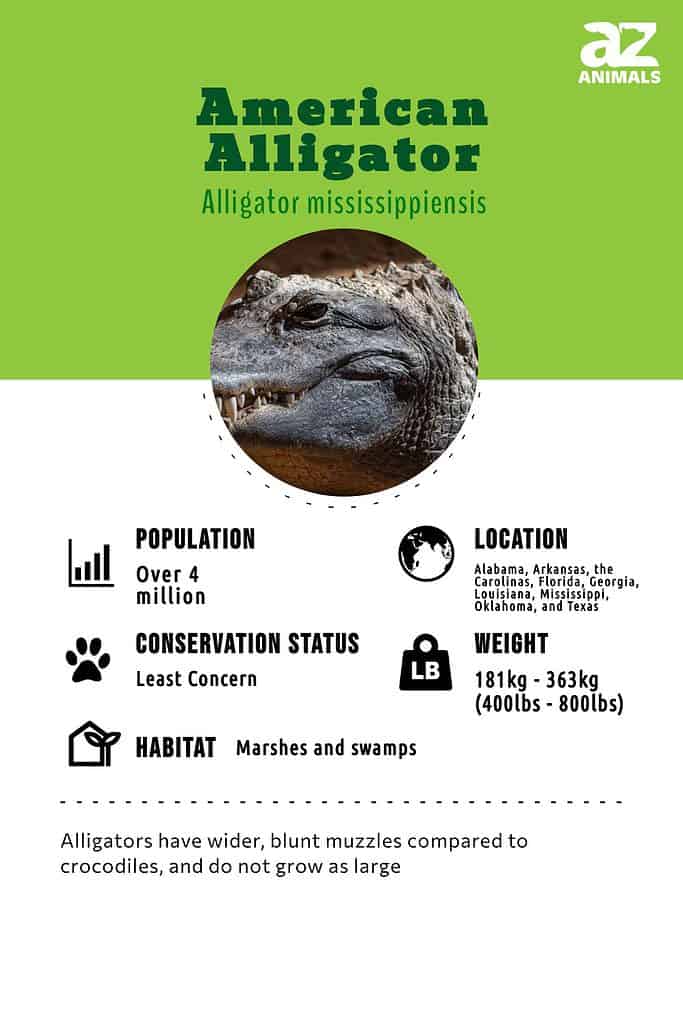
Classification and Evolution
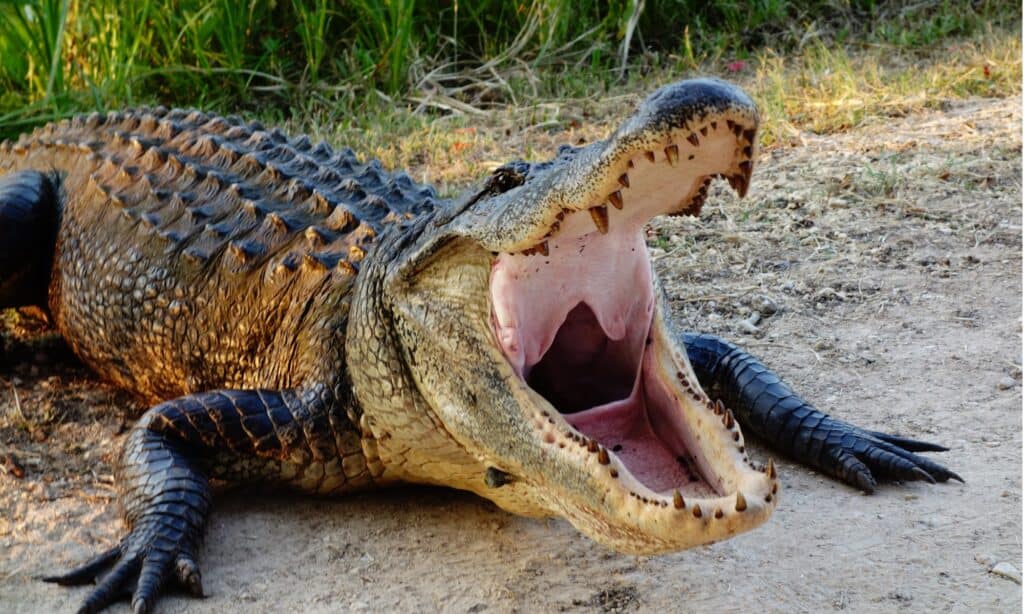
Alligators are especially fast in spite of their size
©iStock.com/Alex Pankratov
Alligators are in the same family as other large reptiles like Crocodiles but are native to only two countries, which are the southern USA and China (where the Alligator is now nearly extinct). Alligators tend to be smaller than their Crocodile cousins but have been known to move at speeds of up to 15mph on land making them one of the fastest large reptiles in the world. Despite their size, there are a number of distinct differences between Alligators and Crocodiles as an Alligator’s snout is shorter than that of a Crocodile, and with their mouths shut, an Alligator’s teeth cannot be seen but a Crocodile’s can. Alligators are also commonly known as Gators in their native, southern North American habitats.
Anatomy and Appearance
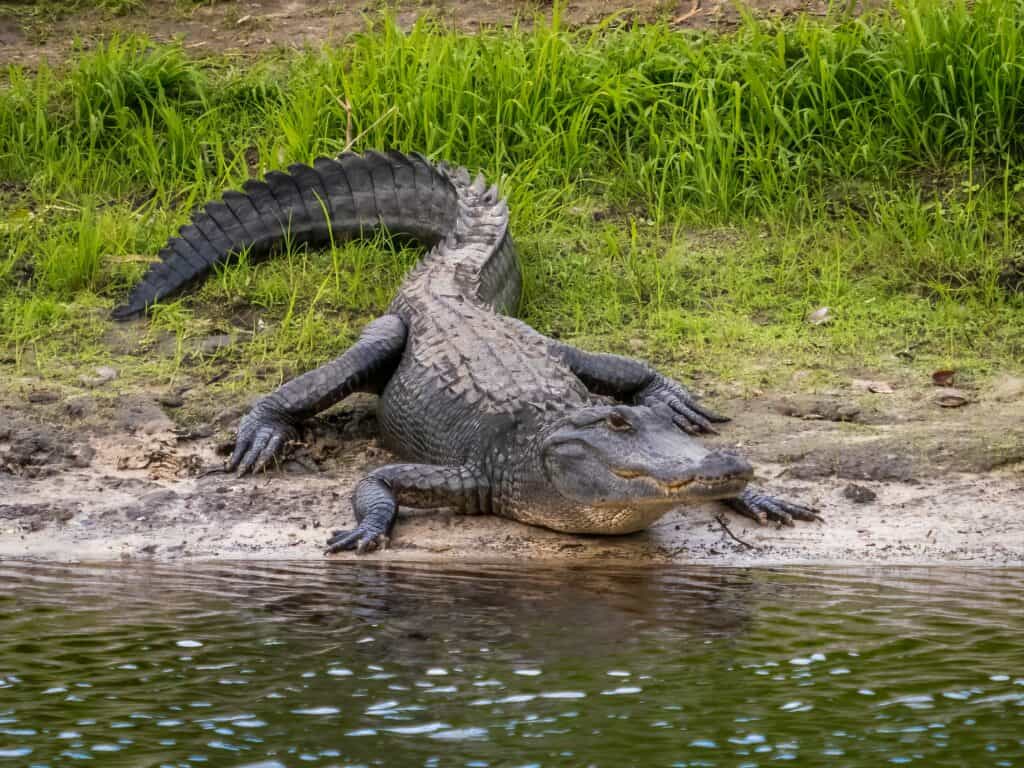
Alligators’ short stocky legs and webbed feet enable them to navigate muddy areas with ease
©Jim Schwabel/Shutterstock.com
Alligators are very large reptiles, with males growing up to 4.5 meters in length. The female Alligator tends to be slightly smaller, with a total body and tail length of between 3 and 3.5 meters. The Chinese Alligator is a much smaller species, almost half the size of a female American Alligator. Alligators have an armour-plated body that varies in color from yellow to green, to brown, finally turning almost completely black in old age. The tail of the Alligator is incredibly muscular and is used to propel the animal when it is in the water. Alligators have short, stocky legs with webbing between their toes. This not only helps them when they are swimming but also means that they can negotiate muddy river banks with ease.
Alligators have multiple stomachs. The first part of their stomach contains stones to grind up food, while the second part is extremely acidic and aids in digestion.
Distribution and Habitat
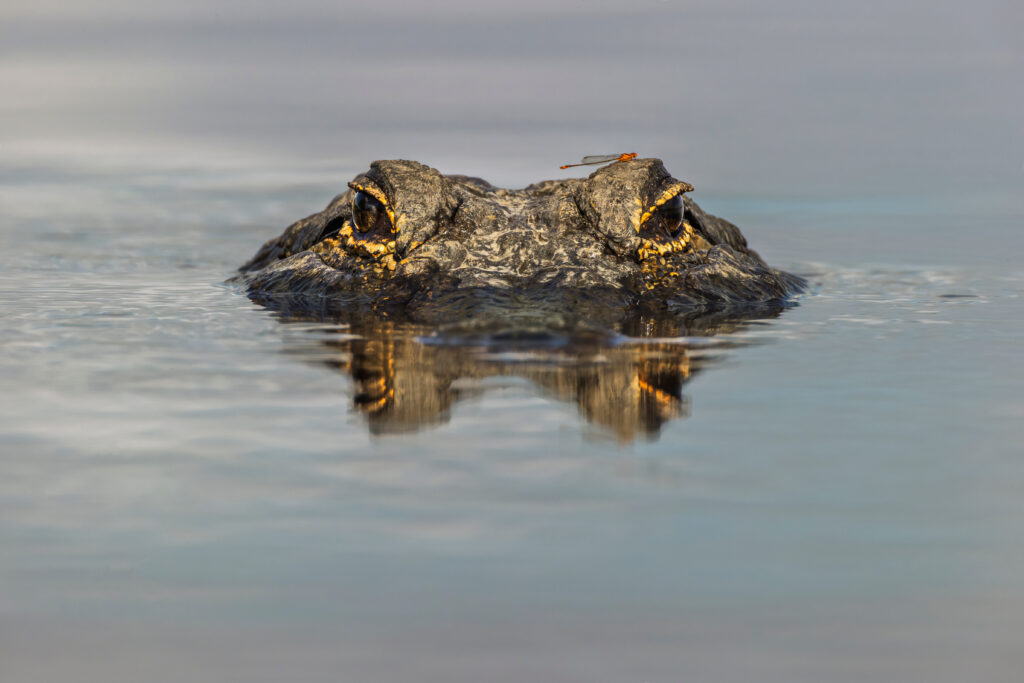
American alligators prefer freshwater and brackish environments
©Danita Delimont/Shutterstock.com
American Alligators are found in the south-eastern USA, throughout all of Florida and Louisiana, the southern parts of Georgia, Alabama, and Mississippi, coastal South and North Carolina, eastern Texas, the south-eastern corner of Oklahoma, and the southern tip of Arkansas. The majority of American Alligators inhabit Florida and Louisiana, with over a million alligators thought to be found between the two states. American Alligators live in freshwater environments, such as ponds, marshes, wetlands, rivers, lakes, and swamps, as well as brackish environments. Southern Florida is the only place in the world where both Alligators and Crocodiles are known to live in the same place.
Population By State
The population of American Alligators by state is estimated to be:
- Louisiana: 2 million
- Florida: 1.3 million
- Texas: 400,000 to 500,000
- Georgia: 200,000 to 250,000
- South Carolina: 100,000
- Alabama: 70,000
- Mississippi: 32,000 to 38,000
- Arkansas: 2,000 to 3,000
- North Carolina: 1,000
- Oklahoma: 100 to 200
Behavior and Lifestyle

The Alligator is a solitary predator that is actually surprisingly clunky when moving about on land. They tend to be quite slow, moving by either crawling or sliding along the slippery banks on their bellies. They are highly territorial animals that are known to make a variety of noises to represent different things, including the declaration of territory, finding a mate, or the young warning their mother that they are in danger. Male alligators however do not appear to have such a prominent voice box and make very little noise outside of the breeding season, when they are known to growl and bellow to fend off competing males.
Reproduction and Life Cycles
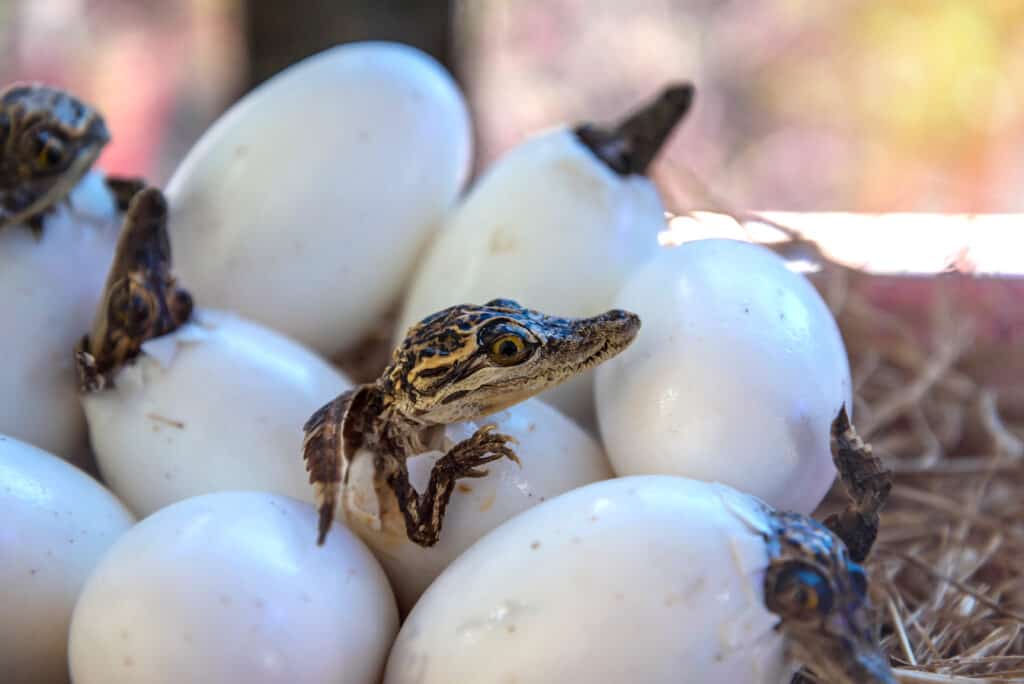
Baby alligators hatch after an incubation period of 2 months
©iStock.com/Casanowe
Alligators tend to breed during the spring when they come together in large groups to find a suitable partner. The female constructs a nest out of mud, leaves, and twigs on the ground where she lays up to 50 eggs. The hatchlings emerge after a 2-month incubation period which occurs in the nest’s rotting vegetation. Females do not incubate their eggs as they would break them but still guard their nest from hungry predators. The baby Alligators are between 15 and 20 long when they hatch and are vulnerable to predation from a number of species. They usually remain with their mother for the first 2 years. Alligators tend to live to about 50 years old or so but some have been known to live at least another 20 years when in captivity.
To know more about the alligator mating season, read here.
Diet and Prey
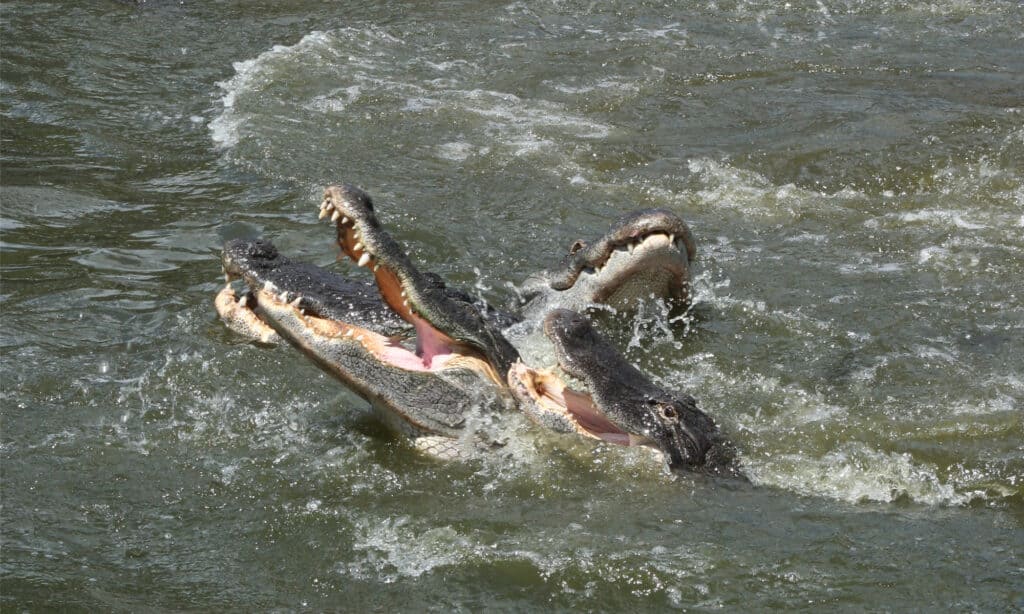
Alligators enjoy a varied diet which consists of birds, fish, and small mammals
©iStock.com/Nigel Stripe
The Alligator is generally a solitary predator, but smaller and younger individuals however are known to stay together in groups especially when hunting. The reptile eats fish, small mammals and birds, but has also been known to attack much larger animals. Adult alligators have been known to hunt Deer and are well known to kill and eat smaller Alligators. In some cases, larger individuals have been known to hunt the Florida Panther and Black Bears, making the alligator the dominant predator throughout their environment. Attacks on pets and even people are also not unknown.
Read here to know about the alligator’s death roll.
Predators and Threats
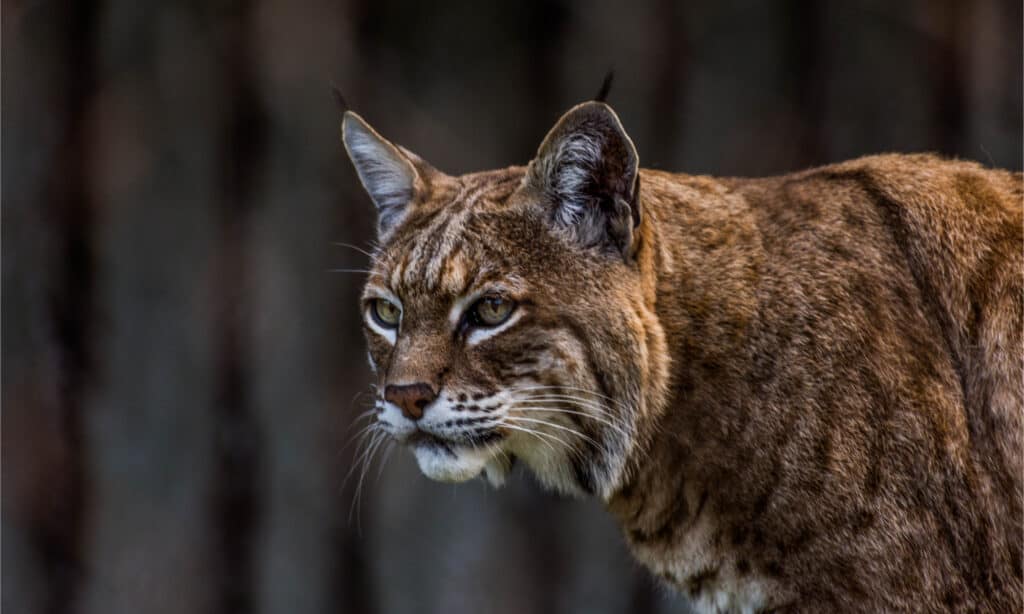
Bobcats are partial to tender, succulent alligator hatchlings
©Victor Arita/Shutterstock.com
The Alligator is an apex predator in its environment, known to even hunt animals that are much larger in size. Humans are the only predator of adult Alligators as they were hunted almost to extinction for their meat, and for their unique skin which was used in the manufacture of a variety of products. The smaller, baby Alligators however, are prey to a number of species including Raccoons, Birds, Bobcats, and even other Alligators. Despite being protected from hunting in much of its North American range today, Alligators are threatened by the loss of their natural habitats and high levels of pollution in the water.
Interesting Facts and Features
Alligator DNA is thought to date back to even before Dinosaur times meaning that the Alligators survived whatever it was that the dinosaurs didn’t, with the scientific estimates first dating the species 150 million years ago. The Chinese Alligator is currently found only in the Yangtze River Valley and the Chinese Alligator is now extremely endangered with less than 100 Chinese Alligators believed to be left in the wild. There are actually many more Chinese Alligators that live in zoos around the world than can be found in the wild today. Alligators are known to have up to 80 teeth which are perfectly shaped for biting down on prey. They are even able to regrow those teeth that are lost.
How do you tell the differences separating alligators vs. crocodiles? In general, alligators have a ‘U-shaped’ snout while crocodiles’ snouts are a ‘V-shape.’ In addition, alligators have webbed feet while crocodile feet are not webbed. Finally, alligators are normally a darker color.
Relationship with Humans
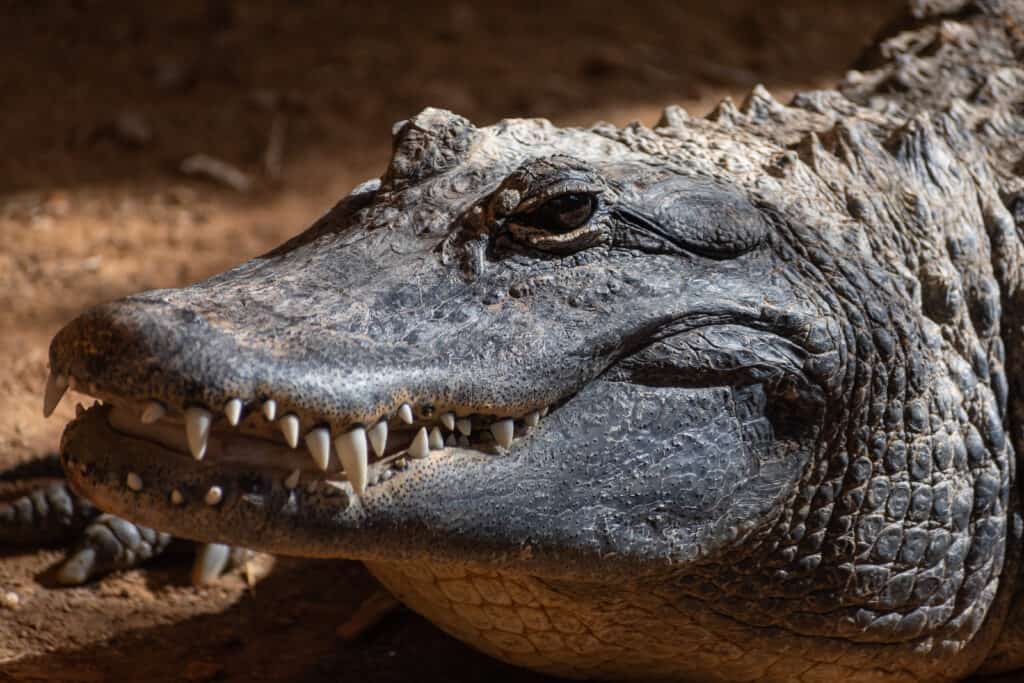
Alligators love to sneak up on pets and will lash out at humans who get to close for comfort
©iStock.com/CoinUp
Unlike large Crocodiles, Alligators do not immediately regard a Human upon encounter as prey, but the Alligator may still attack in self-defence if provoked. Alligator attacks are uncommon but they have definitely been known to attack Humans if they infringe on the reptile’s territory and particularly if the animal feels threatened. They are however known to commonly prey on domestic animals including pets and sometimes livestock when they are close to Human settlements. Hunting towards the end of the last century almost completely obliterated the entire American Alligator population (and has pretty much done so to the Chinese Alligator). Fortunately the gravity of the situation in the USA was realized before it was too late, with the protection of the species having led to an increase in population numbers now.
Conservation Status and Life Today
The American Alligator was once an Endangered species but thanks to habitat protection and federal laws protecting them, populations throughout Florida and Louisiana have recovered really well, with over four million Alligators thought to exist in the USA today. They are however now threatened by habitat degradation, mainly in the form of deforestation and pollution in the water. The story of the Chinese Alligator however is very different, with less than 100 individuals thought to be left in the Yangtze River Valley, this species is Critically Endangered in the wild and is sadly on the verge of extinction.
More Articles on Alligators
Read about:
View all 194 animals that start with AAmerican Alligator FAQs (Frequently Asked Questions)
Are Alligators herbivores, carnivores, or omnivores?
Alligators are Carnivores, meaning they eat other animals.
What Kingdom do Alligators belong to?
Alligators belong to the Kingdom Animalia.
What class do Alligators belong to?
Alligators belong to the class Reptilia.
What phylum to Alligators belong to?
Alligators belong to the phylum Chordata.
What family do Alligators belong to?
Alligators belong to the family Alligatoridae.
What order do Alligators belong to?
Alligators belong to the order Crocodilia.
What type of covering do Alligators have?
Alligators are covered in Scales.
What genus do Alligators belong to?
Alligators belong to the genus Alligator.
Where do Alligators live?
Alligators live in the southern USA and China.
In what type of habitat do Alligators live?
Alligators live in lakes, marshes and swamplands.
How many eggs do Alligators lay?
Alligators typically lay 35 eggs.
What is an interesting fact about Alligators?
Alligators have two sets of eyelids!
What is the scientific name for the Alligator?
The scientific name for the Alligator is Alligator mississippiensis.
What is the lifespan of an Alligator?
Alligators can live for 30 to 60 years.
What is a baby Alligator called?
A baby Alligator is called a hatchling.
How many species of Alligator are there?
There are 2 species of Alligator.
What is the biggest threat to the Alligator?
The biggest threat to the Alligator is water pollution.
What is another name for the Alligator?
The Alligator is also called the gator.
How fast is an Alligator?
An Alligator can travel at speeds of up to 15 miles per hour.
How do Alligators have babies?
Alligators lay eggs.
What's the difference between American alligators and American crocodiles?
There are many differences between an American alligator and American crocodile. American crocodiles far outweigh American alligators, and they are found in both fresh and saltwater, while American alligators prefer fresh water only.
Who would win a fight between a king cobra and an alligator?
An alligator would win a fight against a king cobra.
Both animals are ambush predators, so the alligator could wait for the king cobra to come to get a drink of water before attacking and killing it. Likewise, the king cobra could wait in tall grass and bite the alligator, but it’s not fast enough to escape the fight and let the gator die off. The gator would turn on its afterburners and bite the snake.
Who would win a fight between a rattlesnake and an alligator?
An alligator would win the fight against a rattlesnake.
Alligators have the advantages over rattlesnakes in size, speed, and defense. Their protective body coating would make it exceptionally difficult for a rattlesnake to deliver the venom it would need to inject to win the fight. Alligators’ oversized form and capacity for speed would be strong factors in defeating these venomous serpents. They’ve been known to consume venomous pit vipers like rattlesnakes, apparently resistant to any ill effects of their venom.
Who would win a fight between a hippo and an alligator?
A hippo would win a fight against an alligator.
Simply put, alligators don’t have the toolkit to bring down and kill something as large as a hippo. Even if the average alligator ambushed a hippo and tried to perform a death roll, it’s not going to get much for its effort. The hippo is too thickly built and heavy.
Who would win a fight between a tiger and an alligator?
A tiger would win a fight against an alligator.
However, this ruling comes with a few caveats. If a hungry tiger decides to attack an alligator on land, the alligator would have no chance.
Who would win a fight between an anaconda and an alligator?
An alligator would win a fight against an anaconda.
Although anacondas are large, effective ambush predators, they would have to perform an incredible ambush at the alligator’s head to disable it to such an extent that it could not fight back and kill it.
Who would win a fight between a grizzly bear and an alligator?
A grizzly bear would win a fight against an alligator.
Although the alligator has a very powerful bite, it cannot match the grizzly bear for sheer power. The best-case scenario for the alligator is that it ambushes the grizzly bear on land. Even in that case, the alligator might bite a leg, but it would catch a swift, smashing paw to the head that has enough power to knock it unconscious.
Who would win a fight between a giant boa and an alligator?
An alligator would win a fight against a giant boa.
Most of the fights in the wild are decided by size or the presence of a particularly deadly attack, like venom. In this case, the boa is much smaller than the alligator and has to wrap its body around the reptile to kill it.
What are some extinct alligators?
The largest extinct relative of alligators was Deinosuchus. This massive alligator reached about 39 feet in length and had a bite force that’s estimated at up to twice the force of a Tyrannosaurus Rex!
What are the differences between a Nile crocodile and an alligator?
The biggest differences between a Nile crocodile and an alligator include their size, morphology, and habitats.
What are the differences between an American crocodile and a Nile crocodile?
The greatest differences between an American crocodile and a Nile crocodile are their size, colors, and location. The American crocodile grows to an average length of between 9 and 13 feet and weighs up to 800 pounds, and the Nile crocodile averages 9 to 15 feet in length and weighs between 500 and 910 pounds on average.
How to say American Alligator in ...
Thank you for reading! Have some feedback for us? Contact the AZ Animals editorial team.
Sources
- David Burnie, Dorling Kindersley (2011) Animal, The Definitive Visual Guide To The World's Wildlife / Accessed December 5, 2008
- Tom Jackson, Lorenz Books (2007) The World Encyclopedia Of Animals / Accessed December 5, 2008
- David Burnie, Kingfisher (2011) The Kingfisher Animal Encyclopedia / Accessed December 5, 2008
- Richard Mackay, University of California Press (2009) The Atlas Of Endangered Species / Accessed December 5, 2008
- David Burnie, Dorling Kindersley (2008) Illustrated Encyclopedia Of Animals / Accessed December 5, 2008
- Dorling Kindersley (2006) Dorling Kindersley Encyclopedia Of Animals / Accessed December 5, 2008
- Alligator Facts / Accessed December 5, 2008
- About Alligators / Accessed December 5, 2008
- Alligator Facts / Accessed December 5, 2008


















